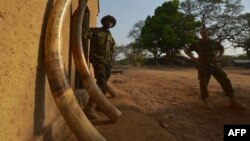The mighty African elephant and the shy, reclusive rhinoceros are the stars of this year’s conference of members of a global wildlife protection treaty in South Africa.
As the meeting of the Convention on International Trade in Endangered Species of Wild Fauna and Flora (CITES) began Saturday, hundreds of protesters massed in Johannesburg to argue against a proposal from Zimbabwe and Namibia to allow legal trade of elephant ivory. Tiny Swaziland has proposed allowing legal trade in rhino horn.
Host nation South Africa supports both proposals and argues that legal trade in such goods can benefit conservation efforts and help the economy. They face stiff opposition from the majority of CITES’ 183 members.
“The sustainable use of the country’s indigenous biological resources is fundamental to the development of South Africa’s economy and social transformation,” South African President Jacob Zuma told the assembled members during the meeting’s opening ceremony. “In this regard, game farming, the hunting industry, eco-tourism and bio-prospecting play a significant role.”
The 3,000 delegates will also review trade restrictions and allowances for tens of thousands of other, less-known species. Members meet every two to three years to review the 41-year-old treaty that covers more than 5,600 animal and 30,000 plant species.
Tough debate expected
Shubert Mwarabu is an elephant campaigner from Tanzania. He came to Johannesburg to make three demands of his country: the arrest and prosecution of all ivory traders, and for his nation to work closely with China to close its ivory market. China has already announced it will close its domestic ivory markets by the end of this year.
It’s the third demand that is controversial -- setting all of Tanzania’s ivory on fire. In April, Kenya torched its stockpile of millions of dollars’ worth of ivory and rhino horn.
“We seek the public destruction of the ivory stockpile of Tanzania, which we believe ...is the largest in the world,” he said. “…the presence of legal ivory markets -- supposed legal ivory markets -- the previous records show that once the one-off sales were allowed, some small countries used that to penetrate the ivory from their stockpiles.”
But some wildlife campaigners say legal trade is beside the point. That’s why Richard Thomas of global wildlife monitoring network TRAFFIC says his organization doesn’t side with either party.
“I’m on neither side, actually, because we believe that this is not where the real issue is with tackling the poaching crisis,” he told VOA. “It shouldn’t be at this stage about whether or not a legal ivory trade should or shouldn’t be allowed, it’s about tackling the poaching and clamping down on the illegal ivory trade. And this can only be able to (be) achieved by international collaboration.”
Conference participants will meet for 12 days, and CITES Secretary-General John Scanlon predicts it will be a rough - but ultimately productive - debate.
Invoking the passion of both sports-mad South Africa and his home country, Australia, he compared the upcoming deliberations to a bruising rugby match.
“People play hard,” he said “and they play to win.”








